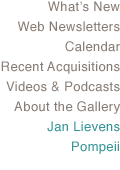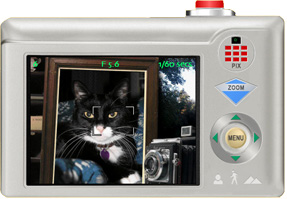The Gibbs-Coolidge Set of Presidential Portraits
West Building, Main Floor Gallery 65
In time for the inauguration of the forty-fourth president of the United States, the Gallery has installed Gilbert Stuart's iconic paintings of the country's first five presidents. These portraits of George Washington, John Adams, Thomas Jefferson, James Madison, and James Monroe have come to define how the nation remembers and pictures these famous men. They will be on view with other fine examples of Stuart's American portraits from the late eighteenth and early nineteenth centuries.
PHOTO OP is a two-part interactive introduction to digital photography and image editing. Use the virtual camera to snap pictures, then experiment with the easy-to-use photo editing tools to give your art a whole new look. The special effects palette, colorizing options, collage tools, warps, and mirrors will transform your photographs. This program is suitable for all ages. (Shockwave, 7 MB)
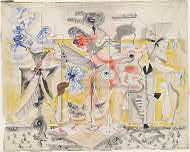 National Gallery of Art Seeks Drawings, Watercolors, and Paintings on Paper by Mark Rothko for Essential Reference Volumes
National Gallery of Art Seeks Drawings, Watercolors, and Paintings on Paper by Mark Rothko for Essential Reference Volumes
As part of a worldwide initiative, the National Gallery of Art is seeking information about drawings, watercolors, and paintings on paper in public and private collections by the American artist Mark Rothko (1903–1970). The National Gallery of Art is publishing a multivolume catalogue raisonné, Mark Rothko: The Works on Paper, which will document more than 2,700 objects that are largely unknown to both art specialists and the public. Demonstrating the range of Rothko's creative achievements, these volumes will be the definitive historical record of Rothko's oeuvre on paper for decades to come.
To submit information, please download a PDF of the catalogue raisonné questionnaire or contact us at (202) 842-6779 or by e-mail at rothko@nga.gov.
 Center 28 Now Available Online
Center 28 Now Available Online
The Center for Advanced Study in the Visual Arts is a research institute at the Gallery promoting study of the history, theory, and criticism of art, architecture, and urbanism from prehistoric times to the present. Its current annual report, Center 28, is now available on our Web site and contains information regarding the Center's fellowships, meetings, research, and publications, as well as research reports by fellows in residence during the 2007–2008 academic year. Fellows from 10 different countries focused on research topics ranging from artists' rivalries and competitions in Renaissance Italy to Christian icons and Kongo symbols in early modern Central Africa.
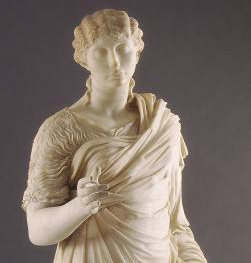 Pompeii and the Roman Villa: Art and Culture around the Bay of Naples
Pompeii and the Roman Villa: Art and Culture around the Bay of Naples
Through March 22, 2009
This exhibition presents some 150 works of sculpture, painting, mosaic, and luxury arts, most of them created before the eruption of Mt. Vesuvius in 79 AD. Exquisite objects from the richly decorated villas along the shores of the Bay of Naples and from houses in the nearby towns of Pompeii and Herculaneum reveal the breadth and richness of cultural and artistic life, as well as the influence of classical Greece on Roman art and culture in this region.
 Documenting Discovery: The Excavation of Pompeii and Herculaneum
Documenting Discovery: The Excavation of Pompeii and Herculaneum
Through March 20, 2009
Assembled in the Study Center of the National Gallery of Art is a selection of works documenting the finds at two of the most important sites: Herculaneum, which was first excavated in 1738, and Pompeii, first excavated in 1748. From books on interior design to collection catalogues depicting artifacts found at the sites, from accounts of the tragedy and studies of daily life in these ancient cities to souvenir photograph books for travelers on their Grand Tour, we present a cross section of the types of works produced from the mid-18th through the 19th century. They provide not only a window to the ancient world, but also a view of how those who excavated the sites and evaluated the artifacts saw that ancient world.
Purchase an Exhibition Catalogue
Visit the National Gallery Shop Online
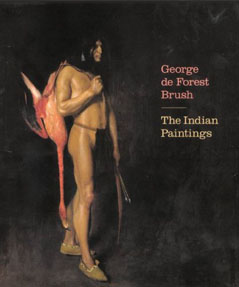 |
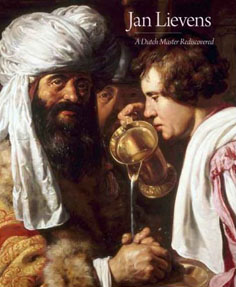 |
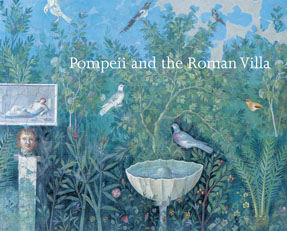 |
| George de Forest Brush: The Indian Paintings | Jan Lievens: A Dutch Master Rediscovered | Pompeii and the Roman Villa: Art and Culture around the Bay of Naples |
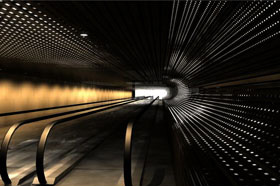 Leo Villareal Installation in the Concourse
Leo Villareal Installation in the Concourse
Monday, September 8 marks the beginning of the installation of Leo Villareal's LED (light-emitting diode) project designed for the Gallery's Concourse. Villareal's work features movement and light, qualities that make this installation particularly well-suited for the moving walkway between the East and West Buildings, a subterranean area through which thousands of people pass daily. The installation features approximately 40,000 LED nodes that run through channels along the entire length of the connecting link. The artist will program sequences using custom-designed software to create abstract configurations of light through electronic circuitry. Villareal's programming both instructs the light and allows for an element of chance. While it is possible that a pattern will repeat during a viewer's experience, it is highly unlikely. Still, the eye will seek patterns in the motion, a perceptual effect of the hypnotic trailing lights.
A digital simulation of the finished project will be on view at the east end of the Concourse throughout the installation process. Traffic on the moving walkway will be intermittently halted, but visitors will always be able to pass through the space and view the work in progress. Once installed, Villareal's project will be on view for one year.
In Memoriam: Robert Rauschenberg (1925–2008)
 In Robert Rauschenberg's practice, sculpture, painting, drawing, printmaking, photography, theater, dance, video, poetry, and musical composition all expanded to absorb the everyday and accidental. He challenged preconceptions about the boundaries between art and life and profoundly altered the course of art after midcentury. Learn more about this pioneer artist in our Web feature, which includes links to podcasts, the Gemini G.E.L. Online Catalogue Raisonné, works in the collection, past exhibition features, and more related resources.
In Robert Rauschenberg's practice, sculpture, painting, drawing, printmaking, photography, theater, dance, video, poetry, and musical composition all expanded to absorb the everyday and accidental. He challenged preconceptions about the boundaries between art and life and profoundly altered the course of art after midcentury. Learn more about this pioneer artist in our Web feature, which includes links to podcasts, the Gemini G.E.L. Online Catalogue Raisonné, works in the collection, past exhibition features, and more related resources.
Volunteer at the National Gallery of Art Sculpture Garden
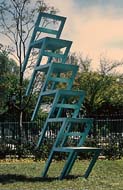 The Sculpture Garden plantings are maintained by the National Gallery of Art horticulture staff. The division of horticulture is currently accepting applications for volunteers. For more information on volunteer opportunities, candidates should submit a letter of interest including all vital contact information to gardens@nga.gov.
The Sculpture Garden plantings are maintained by the National Gallery of Art horticulture staff. The division of horticulture is currently accepting applications for volunteers. For more information on volunteer opportunities, candidates should submit a letter of interest including all vital contact information to gardens@nga.gov.
New Video Podcasts: Empire of the Eye: The Magic of Illusion
 The Magic of Illusion—presented here in a seven-part podcast series—is a film about how we see, what we see, or what it is we think we see. Al Roker guides us on a journey into the secrets of illusion, utilizing special effects to illustrate the artistic and visionary discoveries of the Renaissance. While Copernicus and Columbus were changing our understanding of the world, the Renaissance masters were dramatically changing the way we see that world. The film uses recent technology to look at old works in new ways. Each segment of this podcast presentation unlocks new secrets of illusion and perspective as seen in the works of old masters.
The Magic of Illusion—presented here in a seven-part podcast series—is a film about how we see, what we see, or what it is we think we see. Al Roker guides us on a journey into the secrets of illusion, utilizing special effects to illustrate the artistic and visionary discoveries of the Renaissance. While Copernicus and Columbus were changing our understanding of the world, the Renaissance masters were dramatically changing the way we see that world. The film uses recent technology to look at old works in new ways. Each segment of this podcast presentation unlocks new secrets of illusion and perspective as seen in the works of old masters.
Hi-Res | Lo-Res | iTunes | RSS Introduction, Part 1
Hi-Res | Lo-Res | iTunes | RSS The Trinity—Masaccio, Part 2
Hi-Res | Lo-Res | iTunes | RSS The Church of Santa Maria presso San Satiro, Part 3
Hi-Res | Lo-Res | iTunes | RSS Sant'Ignazio's Ceiling, Part 4
Hi-Res | Lo-Res | iTunes | RSS Palazzo Spada's Corridor, Part 5
Hi-Res | Lo-Res | iTunes | RSS St. Francis of Paola, Performer of Miracles, Part 6
Hi-Res | Lo-Res | iTunes | RSS Teatro Olimpico—Andrea Palladio, Part 7
Subscribe to Our Free E-mail Newsletters
Stay up to date with the National Gallery of Art by subscribing to our free e-mail newsletters: Web, educators, family programs, fellowships/internships, films, gallery talks/lectures, music programs, and teen programs. Select as many updates as you wish to receive. To edit your subscriber information, please go to our subscription
management page.
We would like to hear from you. Please tell us about your visit to the National Gallery of Art. If you would like a reply, please be sure to include your e-mail address.
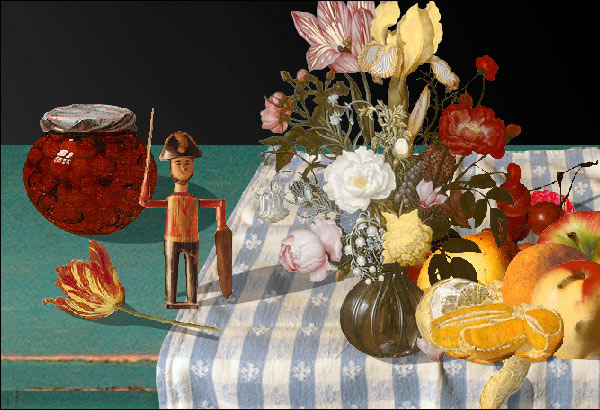 New Interactive: NGAkids Still Life
New Interactive: NGAkids Still Life
The new NGAkids Still Life interactive encourages young artists to explore the world around them by arranging artistic elements and everyday objects into multi-dimensional works that mirror those of the old masters. But there are surprises in store, as some of the objects unexpectedly spring to life! Experiment with spatial arrangements, size variables, and perspective angles, then switch modes and add layers of textured "brushstrokes" to create a more painterly, abstract image. This Art Zone activity is suitable for all ages.
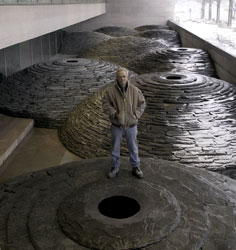 Andy Goldsworthy: Roof
Andy Goldsworthy: Roof
East Building, Ground Level
British sculptor Andy Goldsworthy (b. 1956) was invited by the
National Gallery of Art in January 2003 to create a work for
the Gallery on site or elsewhere in the region. Impressed with
the abundance and character of Washington's stone structures,
Goldsworthy conceived a project reflecting his interest in local
building stones and their geological origins. The resulting project
comprises two phases: ephemeral work completed on Government
Island in Stafford County, Virginia, and a permanent sculpture
located on the Ground Level of the Gallery's East Building. Goldsworthy,
along with his assistant and a team of workers including four
dry-stone wallers from Britain, installed the sculpture entitled
Roof over the course of nine weeks in the winter of
2004/2005. The site specific sculpture comprises nine hollow,
low-profile domes of stacked slate, each with a centered oculus.
View panoramas of Roof in progress.
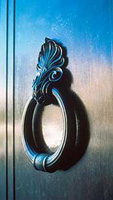 Support
the Gallery:
Make a Gift Online
Support
the Gallery:
Make a Gift Online
The National Gallery of Art relies on a partnership of public
support and private philanthropy to carry out its mission of
service to the nation. You can learn more about giving to the
Gallery through a Web site feature, "Support
the Gallery."
This feature includes information about the many important Gallery programs that benefit from private funding and the various ways to make a gift. We invite you to explore how you can help the Gallery fulfill its mission through a charitable gift.
Visitor Guides
Less Than an Hour? West Building Highlights
(PDF 224k) (Download Acrobat Reader)
Less Than an Hour? West Building Sculpture Highlights
(PDF 136k) (Download Acrobat Reader)
Less Than an Hour? East Building Highlights
(PDF 462k) (Download Acrobat Reader)
Sculpture Garden
(PDF 270k) (Download Acrobat Reader)
For Children: The Great Picture Hunt
(PDF 244k) (Download Acrobat Reader)
Plan your
visit to the National Gallery with these maps of must-see works.
Calendar of Events
Find out what's happening this month at
the National Gallery of Art. To obtain a free bimonthly calendar of events by mail, call (202) 842-6662, or contact us by e-mail at calendar@nga.gov.The current bimonthly Calendar of Events is available in PDF format. (Download Acrobat Reader)
Film Calendar
To obtain a free quarterly film calendar by mail,
contact us by e-mail at film-department@nga.gov.
Please include your mailing address. The current bimonthly Film Calendar is available in PDF format. (Download Acrobat Reader)
Subscribe
![]() Subscribe to the Gallery's "What's New" RSS feed to receive new updates automatically. Help
Subscribe to the Gallery's "What's New" RSS feed to receive new updates automatically. Help

